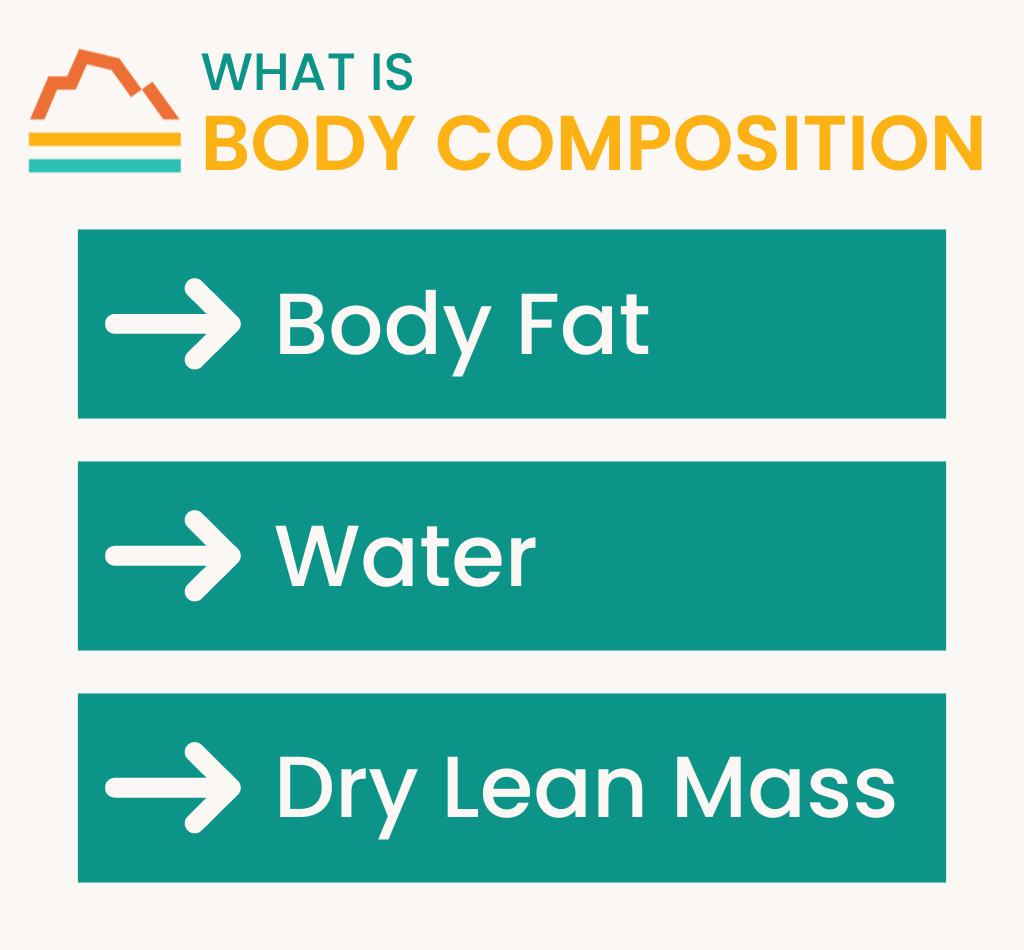Being overweight correlates with a long list of bad health outcomes, including but not limited to:
- Increased risk of diabetes
- Coronary artery disease
- Stroke
- Cancer
- Wear-and-tear osteoarthritis of the joints
Fat is necessary, but excess amounts can hurt us. Therefore, we need to quantify and monitor our total weight in such a way as to prevent bad outcomes.
We need to understand the difference between BMI vs. body composition, and how we can track and learn about the latter.
What Is Our Body Composition?
The healthy range for body fat varies according to age and gender, but for men, it runs between eight and 28%. For women, it’s 21–35%.
But fat is only one component of our body composition. We’re also made of water. Men are about 60% water; women are about 55%.
Whatever isn’t water or fat is called dry lean mass: muscles, bones, connective tissues, etc. Dry lean mass is calculated by subtracting your water and fat quantities from your total body mass.
We’re all made of water, fat, and dry lean mass, but a standard scale won’t tell you exactly how much of each you carry. We need another method to determine our body composition.
What Is BMI?
Let’s discuss BMI vs. body composition. Can you use the former to determine the latter, and vice versa?
BMI (body mass index) is a mathematical ratio calculated based on a person’s total weight and height. Unfortunately, it’s flawed and inaccurate because it doesn’t consider individual body composition.
Very healthy people with increased muscle mass can be considered overweight by BMI standards. For example, an NFL player may have a high BMI (i.e., a high weight for their height) because of their tremendous muscle mass, but no one would recommend they enroll in Weight Watchers!
BMI vs. Body Composition
Since BMI has significant limitations, I looked into other technologies used to measure body composition. Unfortunately, there’s often a trade-off between ease of use and accuracy.
One can use a simple caliper to squeeze available subcutaneous fat at different parts of the body, then calculate the percent body fat using a table. This method is straightforward and cheap, but unfortunately, it isn’t accurate.
Another method is hydrostatic weighing, in which a patient’s body is completely submerged in water, and the displacement and density are calculated. The results are accurate, but the test is clinically impractical.
Other accurate technologies, such as a DEXA (Dual-Energy X-ray Absorptiometry) scan, are convenient but may not be geographically or financially accessible.
After weighing the pros and cons of many body composition calculators, we at Banner Peak Health decided upon InBody, a bioelectrical impedance device.
BMI vs. Body Composition: What Is Bio-Electrical Impedance?
Water conducts electricity, and fat doesn’t, a principle of which InBody takes advantage. The device measures electrical resistance across different axes of the body, from which an accurate calculation of a patient’s body composition (body mass, water, and fat) can be made.
By using this convenient, accurate tool, we address patients’ important clinical issues.
For example, patients who want to lose weight often make lifestyle changes, including dietary and exercise modifications, only to be frustrated when the number on the scale doesn’t change. InBody encourages those patients by showing them how their lifestyle changes have impacted their body. Often, their percentage of body fat decreased as their percentage of muscle increased — so while their overall weight didn’t change, the internal makeup of the body did.
Another clinical benefit of InBody relates to weight loss in aging patients. A prevalent problem called sarcopenia (the loss of muscle mass) is associated with many bad outcomes during the aging process. Fortunately, bioelectrical impedance technology allows us to monitor body composition and watch for decreases in muscle mass.
We invested in this technology because InBody allows us to offer a higher standard of preventative care. We’re delighted to provide it in our office for our members.
The Banner Peak Health Difference
When it comes to BMI vs. body composition, it’s important to take the former with a grain of salt and invest in clinically convenient technologies to determine the latter.
At Banner Peak Health, we’re proud to invest in state-of-the-art diagnostic technologies that can give us greater insight into patients’ health to further customize their treatments, better meet their healthcare needs, and maximize their quality of life.
If you’re interested in using InBody to determine your body composition, schedule an appointment today.


Barry Rotman, MD
For over 30 years in medicine, Dr. Rotman has dedicated himself to excellence. With patients’ health as his top priority, he opened his own concierge medical practice in 2007 to practice medicine in a way that lets him truly serve their best interests.




